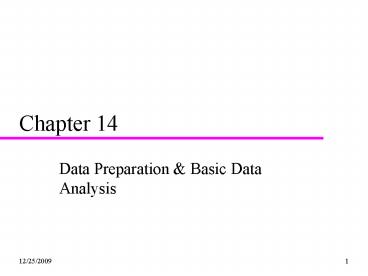Data Preparation PowerPoint PPT Presentation
1 / 32
Title: Data Preparation
1
Chapter 14
- Data Preparation Basic Data Analysis
2
Some types of Variable Respecification (1)
- Reversal of reverse coding
- take number of alternatives plus one minus the
response - for 7-point scale, 8-score.
- Standardization
- equalizing the scale of multiple variables to
allow direct comparison - use z transformation
- z (x-x)/sx
3
Some types of Variable Respecification (2)
- Additive scale construction
- adding scale variables that represent a common
dimension - e.g. five seven-point semantic differential items
to create one 35 point scale with greater
reliability
4
Some types of Variable Respecification (3)
- Dummy coding
- creating binary (classes 2) variables from
multiple class categorical data - requires k (number of original categories) -1
dummy variables
5
Frequency Distributions(one-way tabulations)
- The count, or frequency of occurrence,
- of the alternative responses for a variable
- often produced with a plot (e.g. box or pie) and
- SPSS Statistics/Summarize/frequency
6
SPSS-Frequencies
7
SPSS-Frequencies--Output
8
Descriptive Statistics
- Mean
- median
- mode
- range
- interquartile range
- variance and standard deviation
9
SPSS Descriptive Statistics
10
SPSS Descriptive Statistics
11
Summary of Summary Statistics and Types of Data
- Non-metric Data (Nominal Ordinal)
- frequencies
- mode
- median (ordinal only)
- range interquartile range (ordinal only)
- Metric Data (Interval Ratio)
- mean
- median
- mode
- standard deviation
- range and interquartile range
12
Cross-tabulations (contingency tables)
- The simultaneous frequency distribution of the
alternative responses on two or more variables - Most popular method of studying associations
- Simplest form is two-way (two variables)
- Usually translated into percentages
- A third variable often provides more insight
- SPSS Statistics/Summarize/Cross-tab
13
Transparency 89 Family Income and Number of Cars
Family Owns
14
Transparency 90 Number of Cars by Family Income
15
Transparency 91 Family Income by Number of Cars
16
Transparency 93 Number of Cars by Size of Family
17
Transparency 95 Number of Cars by Income and Size
of Family
18
Addition of a Third Variable in a Cross-tab (1)
- refine association--i.e., show relationship more
pronounced for one level of a third factor than
for another - reveal suppressed association--i.e. how that a
apparent lack of association in aggregated data
is because it is contingent upon the levels of a
third
19
Addition of a Third Variable in a Cross-tab (2)
- Reveal spurious relationship--i.e., an apparent
relationship is actually driven by a spurious
related to both of the original variables - Indicate no change in original relationship
20
SPSS Cross-tab Cells
21
SPSS Cross-tab Output
22
Simple Bar Chart
23
Simple Bar Chart
24
Simple Bar Chart--Output
25
Simple Bar Chart--missing data
26
Two-way Bar-chart
27
Two-way Bar-chart--Output
28
Clustered (three-level) bar-chart (1)
29
Clustered (three-level) bar-chart (2)
30
Clustered (three-level) bar-chart--Output
31
Chi-square (1)
- A general test of association
- Ratio of the difference between observed and
expected cell frequencies (in cross-tab) divided
by the expected frequency - Nullno association
- df (for table) (row cells -1) x
- (column cells -1)
32
Chi-square (2)
- Should not use
- with percentages--use frequencies only
- if any expected cell frequency is 0 or more than
20 percent of cell frequencies less than 5 - SPSS from Cross-tabs or
- Non-Parametric/Chi-square

